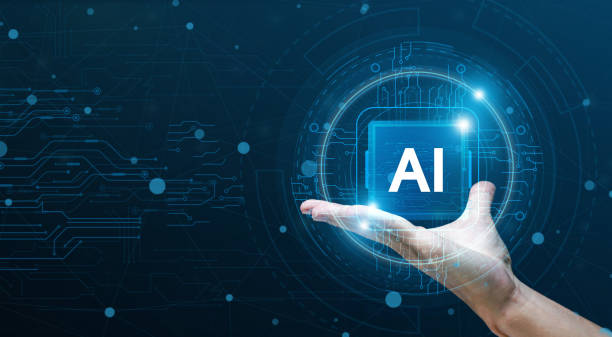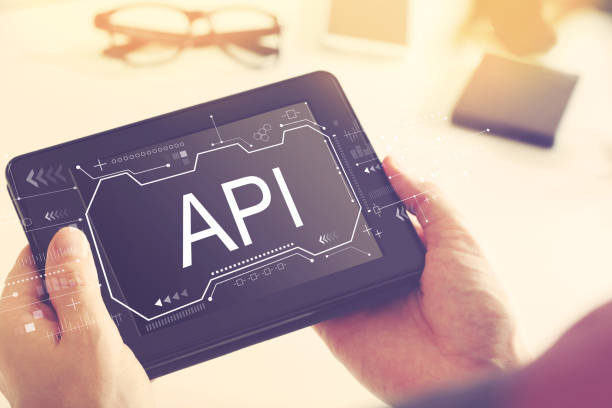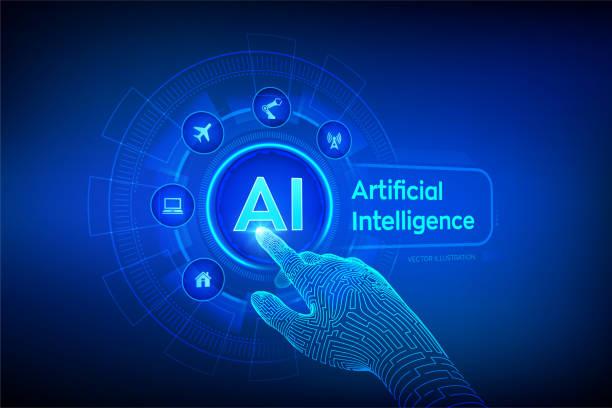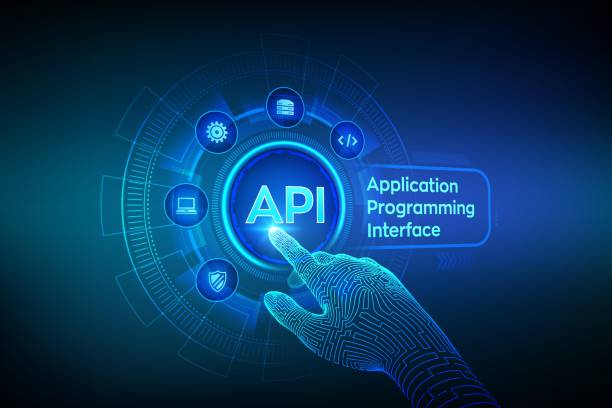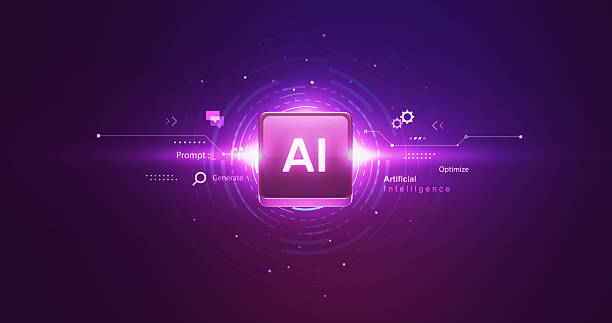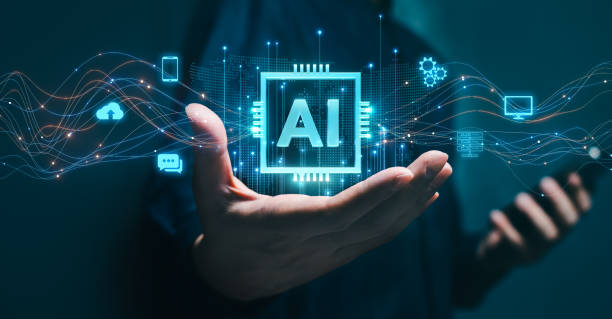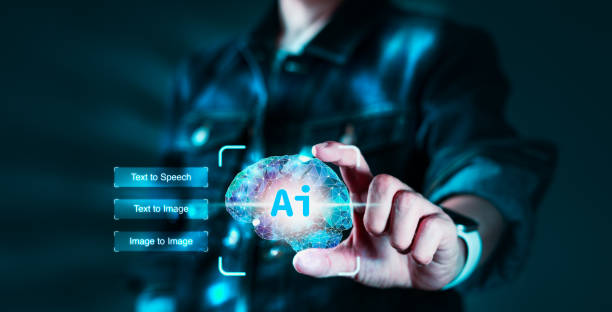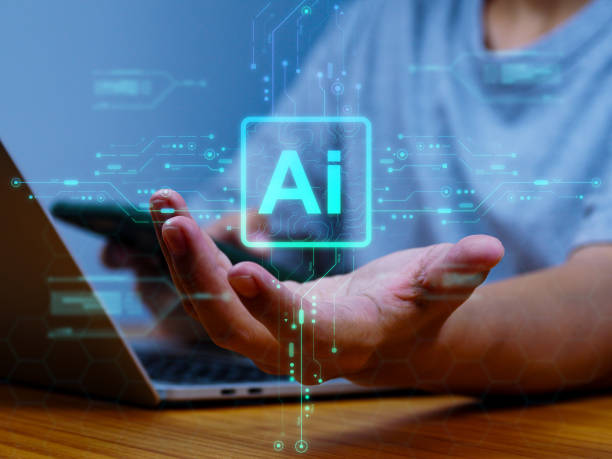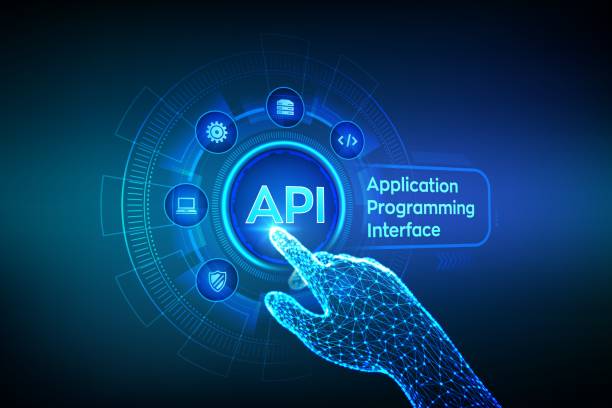What is an Artificial Intelligence Robot and How Does it Work?
#Artificial Intelligence Robot is a combination of two technology fields: #Artificial_Intelligence and #Robotics.
In short, an AI robot is a machine that, using artificial intelligence algorithms, is capable of performing tasks that usually require human intelligence.
These tasks include learning, problem-solving, decision-making, understanding natural language, and pattern recognition.
Artificial Intelligence allows the robot to learn from its experiences, adapt to new conditions, and act independently.
The basis of an AI robot’s operation is data.
The robot, by receiving data through sensors and cameras, processes it and uses AI algorithms to reach a conclusion.
This conclusion can be a decision, a movement, or a response.
For example, an AI robot used in a factory can use cameras to inspect products and separate defective products from the production line.
The main difference between an AI robot and traditional robots is that traditional robots can only perform pre-determined tasks, while an AI robot can learn and perform new tasks.
An AI robot is constantly evolving and progressing, and it is expected to play a more important role in our lives in the future.
These robots can be used in various fields such as industry, medicine, education, and services.
Is your current online store website design not generating the sales you expect?
Rasaweb specializes in professional online store website design!
✅ An attractive and user-friendly website with the goal of increasing sales
✅ High speed and security for an ideal shopping experience⚡ Get a free consultation on online store design with Rasaweb!
Main Components of an AI Robot
An AI robot consists of several main components, each of which plays an important role in its performance.
These components include sensors, processors, actuators, and artificial intelligence algorithms.
Sensors are responsible for collecting data from the surrounding environment.
This data can include images, sounds, temperature, pressure, and other information.
Processors are responsible for processing the data collected by the sensors.
Processors analyze the data using artificial intelligence algorithms and reach a conclusion.
Actuators are responsible for performing physical actions.
These actions can include movement, grabbing objects, speaking, and other activities.
Artificial intelligence algorithms are the brains of an AI robot.
These algorithms enable the robot to learn, solve problems, make decisions, and act independently.
For example, an AI robot used in a hospital can use sensors to collect a patient’s vital signs, use processors to analyze the data and make a medical diagnosis, and use actuators to inject medication into the patient.
Click here to preview your posts with PRO themes ››
The interaction of these components enables the AI robot to perform complex tasks automatically.
Improving any of these components can lead to increased robot efficiency and capabilities.
The AI robot, as a powerful tool at the disposal of mankind, is transforming various industries.
Diverse Applications of AI Robots in Various Industries
AI robots are currently used in various industries, and their applications are expanding every day.
In industry, AI robots can be used to perform repetitive and dangerous tasks, such as welding, painting, and packaging.
In medicine, AI robots can be used to assist surgeons in performing complex operations, diagnose diseases, and provide remote medical care.
In education, AI robots can be used to provide personalized instruction and help students learn new concepts.
In services, AI robots can be used to provide customer service, answer questions, and perform administrative tasks.
AI robots are even used in homes.
For example, robotic vacuum cleaners and cleaners are among these.
In addition to these applications, AI robots can also be used in other fields such as agriculture, transportation, and security.
In general, AI robots can be used in any field that requires repetitive, dangerous, or complex tasks to be performed.
The use of AI robots can lead to increased productivity, reduced costs, and improved quality of life.
For example, in the agricultural sector, robots can be used for planting, harvesting, and spraying crops, which can lead to increased production and reduced water and fertilizer consumption.
Here is a table of applications of AI robots in various industries.
| Industry | Applications |
|---|---|
| Manufacturing Industry | Production line automation, quality inspection, material handling |
| Medicine | Robotic surgery, disease diagnosis, patient care |
| Education | Personalized education, assistance to students |
| Services | Customer service, answering questions, performing administrative tasks |
| Agriculture | Planting, harvesting, spraying |
Advantages and Disadvantages of Using AI Robots
The use of AI robots has numerous advantages and disadvantages that should be considered before using them.
Advantages of using AI robots include increased productivity, reduced costs, improved quality of life, performing dangerous tasks, and providing better services.
AI robots can work continuously and without fatigue, which can lead to increased productivity.
AI robots can perform dangerous tasks without endangering human lives, which can lead to a reduction in accidents and injuries.
However, the use of AI robots also has disadvantages.
Disadvantages of using AI robots include the high cost of purchase and maintenance, the need for expertise to program and maintain them, and the potential for unemployment.
AI robots can be expensive, which can be a barrier to their use in small and medium-sized businesses.
Also, the use of AI robots can lead to job losses for some people.
However, this problem can be reduced by providing appropriate training and creating new job opportunities in the field of artificial intelligence and robotics.
Is your current online store website design causing you to lose customers and sales?
Rasaweb is your solution with modern and user-friendly online store website designs!
✅ Significant increase in conversion rates and sales
✅ Creating strong branding and gaining customer trust
⚡ Get a free online store website design consultation from Rasaweb!
Challenges Facing the Development of AI Robots
The development of AI robots faces numerous challenges.
One of the main challenges is the high cost of research and development.
Developing artificial intelligence algorithms and building advanced robots requires a lot of investment.
Another challenge is the need for large and high-quality data.
AI robots need a lot of data to learn and function correctly.
Collecting and processing this data can be difficult and expensive.
In addition, ethical issues are also among the challenges facing the development of AI robots.
It must be ensured that AI robots are used responsibly and with respect for human rights.
For example, the use of AI robots for military and espionage purposes should be avoided.
Also, it must be ensured that the decisions of AI robots are fair and non-discriminatory.
AI robots should be designed to be able to recognize and avoid unethical behaviors.
Despite these challenges, the development of AI robots continues and is expected to play a more important role in our lives in the future.
With the advancement of technology and the reduction of costs, AI robots will be used more widely in various industries.
AI robots have the potential to improve our lives and help solve major problems.
The Future of AI Robots and Their Impact on Our Lives
The future of AI robots is bright and full of potential.
It is expected that in the future, AI robots will be used more widely in various fields such as industry, medicine, education, and services.
AI robots can help us with everyday tasks, make our lives easier, and improve our quality of life.
For example, AI robots can help us with household chores at home, help us with administrative tasks at work, and help doctors diagnose and treat diseases in hospitals.
AI robots can also play a role in solving major problems such as climate change, poverty, and pandemics.
By using AI robots, data related to these problems can be collected and analyzed, and new solutions for solving them can be presented.
However, it should also be noted that the development of AI robots can also bring challenges.
It must be ensured that AI robots are used responsibly and with respect for human rights.
The use of AI robots for destructive purposes should be avoided, and it must be ensured that the decisions of AI robots are fair and non-discriminatory.
If these challenges are managed correctly, AI robots can become a powerful tool for improving human life.
The Difference Between AI Robots and Automation
Understanding the difference between AI robots and automation is essential to better understand the applications and capabilities of each.
Automation refers to the use of technology to perform tasks that were previously performed by humans.
This is usually done through programming and setting up machinery and systems to perform repetitive and pre-determined tasks.
Automation can be used in production lines, data processing systems, and other areas.
In contrast, AI robots use artificial intelligence algorithms to learn, make decisions, and solve problems.
AI robots can adapt to new conditions and perform tasks that require thinking and reasoning.
While automation is suitable for performing repetitive and pre-determined tasks, AI robots are suitable for performing complex and unpredictable tasks.
AI robots can be used in various fields such as medicine, education, and services.
For example, an AI robot can be used to diagnose diseases, provide personalized education, and provide customer service.
| Feature | Automation | AI Robot |
|---|---|---|
| Type of Tasks | Repetitive and pre-determined | Complex and unpredictable |
| Learning Ability | None | Has |
| Decision-Making Ability | None | Has |
| Adaptability to New Conditions | None | Has |
Ethics in AI Robots: Challenges and Considerations
The development and use of AI robots are associated with several ethical issues that should be considered.
One of the main issues is accountability.
If an AI robot causes damage, who will be responsible? The designer, the manufacturer, or the user? This question still has no definitive answer and requires review and the development of appropriate laws and regulations.
Another issue is privacy.
AI robots can collect a lot of information about us.
How can this information be protected and prevented from being misused? This requires the creation of strict laws and regulations in the field of data protection.
In addition, discrimination is also an important issue.
AI robots can unintentionally act discriminatory, especially if the data used to train them is discriminatory.
To prevent this, diverse and unbiased data should be used to train robots.
Another issue is job loss.
With the advancement of robotics and artificial intelligence, many jobs may disappear.
How can this issue be dealt with and help people learn new skills and find a place in the new economy? This requires investment in education and the creation of new job opportunities.
AI robots can help solve these problems, but it should also be noted that AI robots should not replace humans, but should be used as a tool to help humans.
The development and use of AI robots should be done in accordance with ethical principles and taking into account the interests of all members of society.
Do visitors to your online store website leave before buying? Don’t worry anymore! With Rasaweb’s professional online store website design services, solve the problem of not converting visitors into customers forever!
✅ Significant increase in conversion rates and sales
✅ Unique and attractive user experience
⚡ Contact us now to receive a free consultation!
Most Popular Platforms and Tools for Developing AI Robots
Developing AI robots requires the use of appropriate platforms and tools.
Different platforms exist for developing AI robots, each with its own features and benefits.
Some of the most popular platforms include ROS (Robot Operating System), TensorFlow, PyTorch, and OpenCV.
ROS is a software framework that provides various tools and libraries for developing robots.
TensorFlow and PyTorch are machine learning libraries that are used to train robots.
OpenCV is a computer vision library that is used to process images and videos.
In addition to these platforms, other tools also exist for developing AI robots.
Some of these tools include simulators, data visualization tools, and debugging tools.
Simulators allow developers to test their robots in a virtual environment.
Data visualization tools allow developers to graphically view the data collected by robots.
Debugging tools allow developers to find and fix problems in robot code.
Choosing the right platform and tools for developing AI robots depends on the type of project and the needs of the developer.
How to Build an AI Robot: A Step-by-Step Guide
Building an AI robot can be a challenging but very rewarding project.
This process involves several steps, each of which requires specific knowledge and skills.
First, you must determine your goal for building the robot.
What is your robot supposed to do? What features should it have? After determining the goal, you must obtain the necessary parts.
These parts include sensors, processors, actuators, and a power supply.
You also need a computer and the necessary software to program the robot.
After obtaining the parts, you must connect them together and build your robot.
This usually involves using electronic boards, wires, and other mechanical parts.
After building the robot, you must program it.
This involves writing code to control the robot’s movement, process sensor data, and execute artificial intelligence algorithms.
You can use various programming languages such as Python, C++, and Java to program the robot.
After programming the robot, you must test it and ensure that it is functioning correctly.
This involves running the robot in different conditions and checking its performance.
If there are any problems, you must modify the robot’s code and test it again.
By following these steps, you can build an AI robot and take advantage of its capabilities.
This process requires patience, perseverance, and a desire to learn.
Frequently Asked Questions
| Question | Answer |
|---|---|
| What is an Artificial Intelligence Robot? | An AI Robot is a machine capable of understanding the environment, reasoning, learning, and making decisions to perform tasks independently. |
| What is the difference between ordinary robots and artificial intelligence robots? | Ordinary robots perform repetitive tasks based on prior programming, while artificial intelligence robots can learn from experience, interact dynamically with the environment, and even behave in a way that resembles human intelligence. |
| What are the main applications of artificial intelligence robots? | They are used in industries (manufacturing, assembly), medicine (surgery, diagnostics), services (customer support, domestic), exploration (space, underwater), and many other fields. |
| What technologies are used in the construction of artificial intelligence robots? | Machine Learning, Computer Vision, Natural Language Processing, Deep Learning, and Robotics are among the key technologies. |
| Can artificial intelligence robots have emotions? | Currently, robots do not have emotions in the human sense. They can identify emotions and react to them, but they do not experience emotions themselves. |
| What are the main challenges in the development of artificial intelligence robots? | Safety, reliability, ethics, autonomy, adaptability to complex environments, and natural interaction with humans are important challenges. |
| How are artificial intelligence robots trained? | They are usually trained using a large volume of data, machine learning algorithms, and deep learning to identify patterns and make decisions. |
| Examples of artificial intelligence robots in everyday life? | Smart robotic vacuum cleaners, customer support chat robots, self-driving cars, and surgical robots in hospitals. |
| Are artificial intelligence robots a threat to human jobs? | Some repetitive jobs may be automated, but at the same time, robots can increase productivity and create new jobs in the development, maintenance, and monitoring of these systems. |
| How is the future of artificial intelligence robots predicted? | They are expected to become smarter, more autonomous, and capable of performing more complex tasks, and to interact more closely with humans in various environments. |
And other services of Rasa Web advertising agency in the field of advertising
Smart Google Ads: A quick and efficient solution to increase click-through rates by focusing on the use of real data.
Smart SEO: A combination of creativity and technology for digital branding by customizing the user experience.
Smart Content Strategy: A combination of creativity and technology to analyze customer behavior by using real data.
Smart Sales Automation: Designed for businesses looking to increase sales through intelligent data analysis.
Smart Digital Branding: A combination of creativity and technology for managing campaigns by using real data.
And more than hundreds of other services in the field of internet advertising, advertising consulting and organizational solutions
Internet Advertising | Advertising Strategy | Advertorial Report
Resources
Application of artificial intelligence in robotics
,Artificial intelligence robots: The new generation of machines
,Types of smart robots and their importance
,What is smart robotics?
? Are you ready for your business to shine in the digital world? Rasa Web Digital Marketing Agency, with a specialized and creative team, offers the best comprehensive solutions, including custom website design, SEO optimization, and smart social media management for your sustainable growth and success.
📍 Tehran, Mirdamad Street, next to the Central Bank, Southern Kazerun Alley, Ramin Alley No. 6

